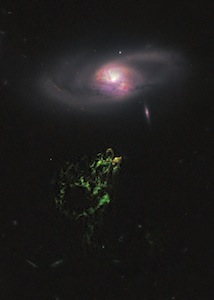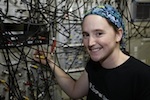GAM 2012 Blog
|
April 12 By Megan Argo |
Back to the GAM Blog |  |
| Did you ever dream of becoming an astronomer when you were a kid? If you are reading this blog, chances are that you did! |
||
Even if your life went in a very different direction, you can still be part of an active astronomy community and participate in real cutting-edge research. How? One of the best ways is through citizen science projects.
 "Citizen science" is the catch-all term for a growing number of projects covering a vast area of scientific research. Such projects directly involve members of the public, people who may or may not have some scientific background or training, and get them participating in real research. Participation in these projects generally requires no prior knowledge, just some time, enthusiasm, and an interest in the subject. Astronomy has no shortage of such projects, some more interactive than others, some requiring more effort than others, but all with one thing in common: absolutely anyone can participate.
"Citizen science" is the catch-all term for a growing number of projects covering a vast area of scientific research. Such projects directly involve members of the public, people who may or may not have some scientific background or training, and get them participating in real research. Participation in these projects generally requires no prior knowledge, just some time, enthusiasm, and an interest in the subject. Astronomy has no shortage of such projects, some more interactive than others, some requiring more effort than others, but all with one thing in common: absolutely anyone can participate.
One of the earliest examples, launched in 1999, the [email protected] project uses the spare CPU capacity of volunteers located around the planet to examine data from radio telescopes in search of potential signals of alien origin. The signals processed by the screensaver are real data from professional radio telescopes, including the 305-metre dish at Arecibo in Puerto Rico. Along similar lines, theSkyNet, launched in 2011, will use spare CPU cycles of volunteers to analyse data from the Australian Square Kilometre Array Pathfinder (ASKAP, a new array of radio telescopes under construction in Western Australia), helping professional astronomers process the enormous volume of data which will be generated by searching for objects which emit radio waves rather than light.
If observing yourself is more your thing, you can participate in efforts to monitor variable stars, measure world-wide light pollution (no telescope required!), or even look for radio signals from Jupiter.
One of the most famous citizen science projects is Galaxy Zoo, an interactive project which is now part of the much larger Zooniverse collection. With Galaxy Zoo, volunteers examine pictures of galaxies from a massive survey of the sky, classifying them into different types and noting any unusual features - a task where humans are far more efficient than computers. All great fun, of course, but what about the science? Since the first classifications in 2007, the Galaxy Zoo project has resulted in an ever-growing list of research papers published in academic journals. Many of these have shown us new insights into the nature of the population of galaxies in our Universe, and some have included citizen scientists amongst the authors.
You could argue that much of this could be done by computer, but one thing a computer can't do is look at an image and go "huh, what's that?" This is precisely what happened in 2007, when Hanny van Arkel, a Dutch schoolteacher participating in Galaxy Zoo, noticed a peculiar cloud in an image of one particular galaxy. This object, which became known as Hanny's Voorwerp, resulted in follow-up observations with several professional telescopes and a collection of scientific papers attempting to uncover its true nature.
While the investigations into Hanny's Voorwerp continued, Galaxy Zoo participants were also asked to go looking for other examples, finding quite a collection of similar-looking curious clouds (known as the Voorwerpjes) associated with other galaxies. These discoveries, all made by the army of Galaxy Zoo volunteers, have led to yet more professional telescope time, including observations with the Hubble Space Telescope and several days of observing time with the Westerbork Synthesis Radio Telescope (WSRT, an array of radio telescopes located in the Netherlands). All of this effort towards trying to understand these new and unusual objects would not have been possible without the dedication and enthusiasm of citizen scientists.
So, feel like getting involved? The Zooniverse now includes a diverse range of projects, not just restricted to astronomy either, and you can also find a collection of science projects, from archeology to climate modelling to molecular biology, at SciStarter. Why not jump in and have a go? Who knows what you might discover!
|
|
Megan Argo is an astronomer currently at the Netherlands Institute for Radio Astronomy (ASTRON). Amongst other things, she is currently working on a mountain of WSRT data on the Galaxy Zoo Voorwerpjes.
|








